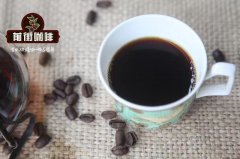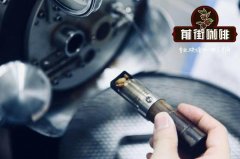The reason why Columbia Huilan doesn't taste good is what Whelan coffee is right.

Professional coffee knowledge exchange more coffee bean information please follow the coffee workshop (Wechat official account cafe_style)
Introduction to Qianjie Coffee-Whelan Coffee hand
Huilan, which grows at an altitude of 900-1100m, has previously been mentioned that the sour taste of beans at this altitude is not particularly obvious, but as a frontier producing area in Colombia, its stability is not to be said. Therefore, the use of water washing method, increased the purity of beans; in baking, the main extraction is the middle mellow, oil and melanin-like section, belonging to medium-deep baking. Understood in this way, this bean is ideal for beginners.
The extraction process of the whole cooking is roughly in the order above, first extracting the fruity and sour taste (the surface of the bean), then the middle taste, then the sweet taste, and finally the bitter taste.
OK, let's take a look at the specific cooking method of this bean. Before that, popularize a few more knowledge points.
1, baking degree: divided into shallow, medium and deep three kinds, generally speaking, shallow baked beans taste outstanding, taste brighter; the deeper the taste, the more mellow, of course, the more miscellaneous flavor, the taste dark.
2. Coffee fiber: the higher the altitude, the shallower the baking, the harder the fiber is, and the less easy it is to extract, so the corresponding steaming time can be lengthened; on the contrary, the lower the altitude and the deeper the baking degree of the beans, the softer the fiber is, the easier it is to extract, and the shorter the steaming time is, or even the steaming time is not stifling.
3. Steaming time: the main purpose of steaming is to let hot water seep into the cell wall of coffee fiber and force out the carbon dioxide, so that the water-soluble matter can be extracted more easily and facilitate the diffusion between coffee cells after secondary water injection. It is generally controlled between 8 and 25 seconds. To see how long the steaming is appropriate, you can observe whether bubbles continue to appear in the steaming process, and when there are no more bubbles or water dripping down the pot, the steaming can end.
4. Degree of grinding: the coarser the degree of grinding is, the less the contact surface is, the cooking time will be lengthened accordingly, and vice versa. It is generally controlled between 2.5 and 4 degrees of grinding.
5. Coffee extraction concentration: only 30% of the substances that can be extracted from a coffee bean are wood fibers that are insoluble in water. According to the "Golden Cup extraction Theory" issued by SCAA, the real extraction rate of a cup of coffee should reach 18%. 22% is the best extraction standard, while the concentration of "substances extracted from coffee" in a cup of coffee is only 1.15%. 1.35% (not surprisingly, about 98% of the coffee we drink is water) So it's not best to extract 30% of the water-soluble substances in every coffee bean. (something like this.)
6. Powder-to-water ratio (can be done with these three schemes)
Scheme A (flavor type)
The ratio of powder to water: 1:18 (light, medium baking, fine powder) concentration 1.15-1.25,18-20
Plan B (balanced)
The ratio of powder to water: 1:15 (medium, medium-deep baking, slightly coarse) concentration 1.28: 1.35, extraction rate: 16-18
Scheme C (mouthfeel)
Ratio of powder to water: 1:13 (medium-deep, deep baking, too much powder, rough grinding) concentration: 1.351.45,14-16
Powder / water ratio: 1:15
Water temperature: 90 degrees
Water injection: 1:2, that is, 20g water, about 4 laps evenly at medium speed.
A small water column is injected from the center, and then slowly wound out, just like gently laying a layer of water on the noodle, although it is a small water column, please be careful not to slow down the circle speed, because once the circle speed is too slow, the water column will flow in a single direction, so that the draught of the powder layer is uneven.
After the end of the first water supply, coffee powder particles will push each other because of exhaust, resulting in expansion.
Steaming: steaming for about 8 seconds, because it is deep baked, personal taste is heavy, 8 seconds steaming taste is thick, basically no miscellaneous smell, with slight sour and obvious chocolate, nutty flavor. When the expansion reaches the highest point or comes to a standstill, it is the time to add water for the second time.
Secondary water injection: quickly draw a circle from the center to the edge, inject 80g of water, and keep the water level full of powder. The purpose of two times of water injection is to make the coffee cells spread rapidly. Basically, 80% of the flavor at this stage will be extracted. The purpose of the rapid circle is to let the water flow produce convection between the cells, thus more evenly soaking into the cell wall. Extract the fruity sour taste and the middle flavor. At the beginning of the second water supply, we should pay attention to the amount of water, and try not to exceed the height of the powder layer, that is, when the water column is wound close to the filter paper, the water supply can be stopped.
Three times of water injection: after staying for 5 seconds, three times of water injection, be sure to keep the flow stable, steady, steady, important things said three times, the remaining water injection until the end. Fast flow and slow flow rate, the circle should be small, the purpose is not to let the fine powder sink to the bottom (because the second water injection is relatively fast, resulting in convection, which will cause the fine powder to sink to the bottom, block the filter hole, resulting in over-extraction), and the coffee powder on the side will be soaked evenly. Otherwise, it is easy to extract the bitter, earthy and astringent taste from the coffee cells, and the taste is very mixed. The ideal state of this process is to mainly extract sweetness. The rolling particles will start to rest because they stop adding water, and at this time they have to rely on the velocity caused by the falling water level to make the coffee particles produce friction, so once the addition of water stops, the coffee powder particles will sink, causing blockage, so pay special attention to the rhythm of adding water.
END
Important Notice :
前街咖啡 FrontStreet Coffee has moved to new addredd:
FrontStreet Coffee Address: 315,Donghua East Road,GuangZhou
Tel:020 38364473
- Prev

Colombia Huilan how to rush correctly Columbia hand flushing method to share
Professional coffee knowledge exchange more coffee bean information please follow the coffee workshop (Wechat official account cafe_style) Qianjie Coffee introduction-Huilan, Colombia, because Huilan area belongs to the mountain terrain, coffee is planted on the slopes of the canyon, so it has a high altitude to grow high quality Arabica beans, as well as the right temperature. The climate of the canyon slope not only prevents the cold wind from blowing,
- Next

African Kenyan coffee bean brewing parameters teach Kenyan AA how to make it sweeter
For more information on coffee beans, please follow the coffee workshop (official Wechat account cafe_style) as early as the 1930s, when ScottLabs was commissioned by the Kenyan government to select the varieties suitable for the country. After screening one by one, SL-28 and SL were finally obtained.
Related
- Beginners will see the "Coffee pull flower" guide!
- What is the difference between ice blog purified milk and ordinary milk coffee?
- Why is the Philippines the largest producer of crops in Liberia?
- For coffee extraction, should the fine powder be retained?
- How does extracted espresso fill pressed powder? How much strength does it take to press the powder?
- How to make jasmine cold extract coffee? Is the jasmine + latte good?
- Will this little toy really make the coffee taste better? How does Lily Drip affect coffee extraction?
- Will the action of slapping the filter cup also affect coffee extraction?
- What's the difference between powder-to-water ratio and powder-to-liquid ratio?
- What is the Ethiopian local species? What does it have to do with Heirloom native species?

